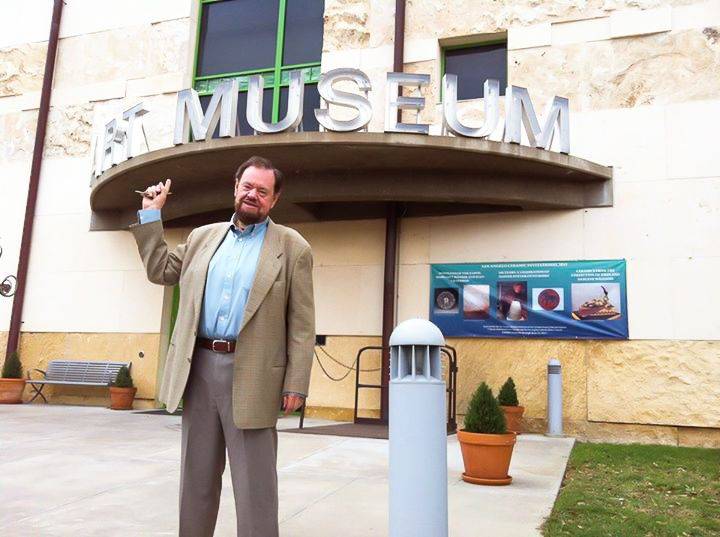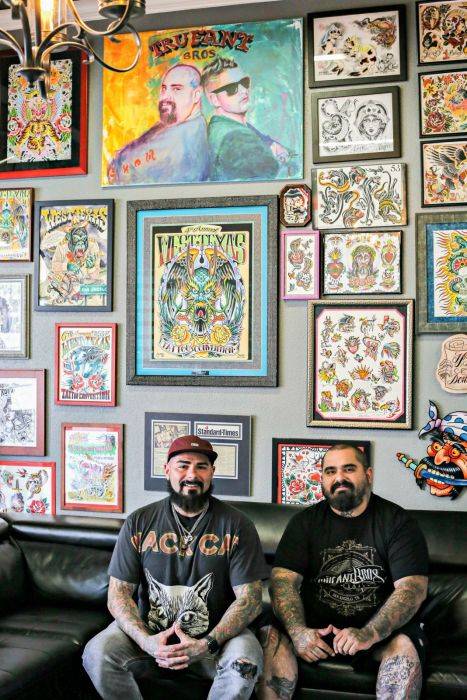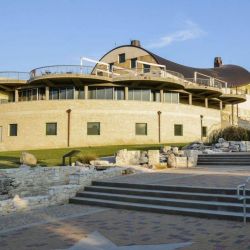Thinking Big from Love St.
San Angelo's Museum of Fine Arts
By BECCA NELSON SANKEY

Decades later, Taylor is working diligently to bring a similar revival to the area surrounding SAMFA. “It’s pretty run down,” he admitted. “You have these great assets, but then around them, empty buildings, blight. It’s out of balance. (Our current buildings) are all about engaging people and making them feel welcome.”
The building that houses Gallery Verde, at 417 S. Oakes St., was constructed in the 1920s but had fallen into disrepair until SAMFA acquired it in 2002 and, with the Upper Colorado River Authority, restored it. For several years, the building served as the UCRA’s education center. Now, as Gallery Verde, a nod to its past function in ecological education, the space showcases the work of contemporary artists.
Coop Gallery, at 427 S. Oakes St., is named in honor of Roger Allen, a longtime museum supporter and founding director of the Old Chicken Farm Art Center. The gallery is community-centered and provides a place for local groups and organizations to showcase their work.
Both spaces “give us the opportunity to do things we can’t do at the art museum,” Taylor said, adding that everything the museum showcases must be educational and encyclopedic, and that all timeframes, cultures and mediums are represented. Along with those early decisions, the museum started the National Ceramic Competition, which has since turned into a juggernaut of an event held every two years. (The Ceramic Invitational exhibit is held odd-numbered years.)

In addition to heading up the San Angelo Cultural District, the largest in America, SAMFA is the statewide headquarters for the Center for the Advancement and Study of Early Texas Art (CASETA), which “promotes the preservation, study and appreciation of Texas visual arts and its history,” according to SAMFA’s website. In addition, the museum partners with Goodfellow Air Force Base in San Angelo to offer DoD STARBASE, a science, technology, engineering and math (STEM) program for fifth-graders held at the base.
As if that weren’t enough, SAMFA is also working on converting the old county library bookmobile into a mobile museum that will travel to rural schools within an 18-county region. The mobile museum will be equipped with art supplies, work tables, technology and will – of course – display art. Taylor hopes to launch the mobile museum this fall. He’s also planning for a summer opening of the Farm and Ranch Museum of the Concho Valley. Located at 305 S. Oakes St., the living museum will pay homage to San Angelo’s roots with a blacksmith’s shop, restored farm machinery, and live demonstrations from farmers and ranchers.
On Sept. 21, the museum will debut its exhibit, “Inside Out: An Exploration of Women’s Status and Roles in Western Society as Reflected in Fashion From Foundation to Silhouette.” Museum-goers can expect to see a timeline of under things and glean a better understanding of how they relate to women’s societal roles, as well as each generation’s definition of body image and its perception of the female form, from the 1800s to present day. “This’ll probably be the biggest exhibit we’ve ever done,” Taylor said.
But Taylor, no doubt, is accustomed to thinking big, as demonstrated by the walls of his office – one covered with awards and certificates, another adorned with framed photos of accomplished faces, from Tibetan monks, to Laura and George Bush, to senators and congressmen. In one photo, Ugandan choir boys are pictured in Taylor’s office, clustered around a painting of his face; the photo was taken while he was out of town.
Asked his reason for all he does for his adopted hometown, Taylor continues to look at the big picture, thinking in terms of we, the museum – not me, Howard Taylor. “It’s very simple,” he said, without hesitation. “To make a better world where people learn to care and respect each other. …they share…that they feel comfortable and right coming to the museum. And that they learn from each other.”
More from Create . . .

A Bond Between Brothers
When most people think about a tattoo parlor, they envision scenes from old movies: Sweaty bikers sitting around a dark, dungeon-like room in a thick fog of cigarette smoke.
Read More
On This Farm He Has Art
The whiz of harried traffic on Martin Luther King Boulevard belies the quiet, funky commune tucked behind pencil-shaped fence pickets. The morning sun bathes the property in a rosy glow. Birds chirp, wind chimes tinkle gently in the breeze and artists – as a sign near the entrance reads – are already at play.
Read More
Art in Uncommon Places
AIUP is the force behind a plethora of prominent art pieces in some of San Angelo’s most public spaces, including the Red Arroyo Trail, along the Concho River Walk, The Bosque, and Firefighter’s Memorial City Park.
Read More




